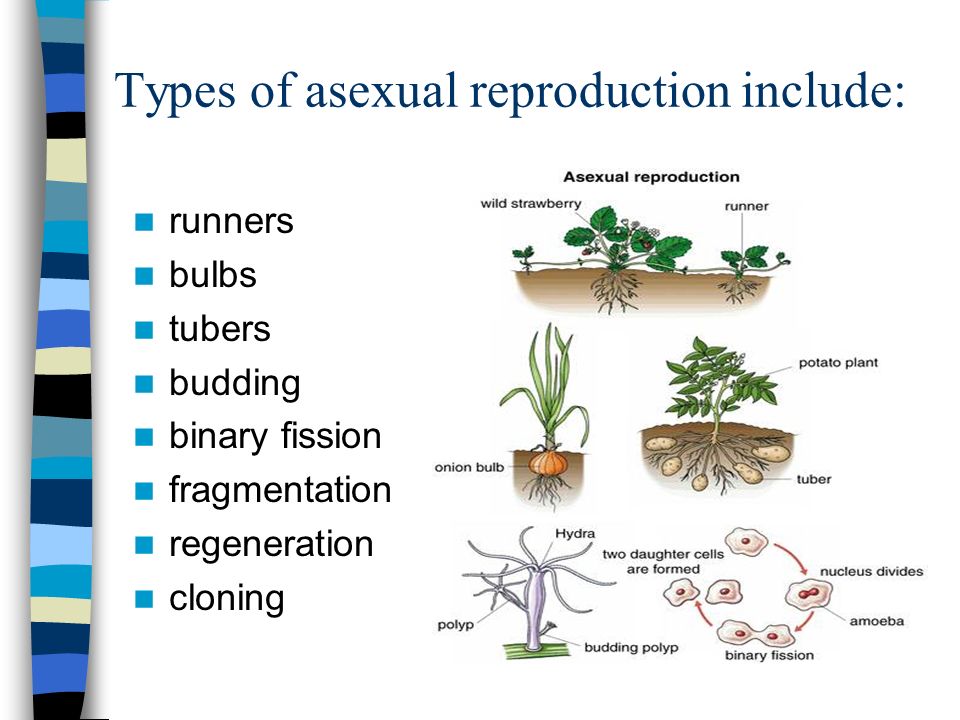Is Cloning A Form Of Asexual Reproduction
Because in asexual reproduction only one parent is needed. Scientist have made some mind boggling achievements with cloning including the asexual reproduction of sheep and cows.
Advantages And Disadvantages Of Asexual Reproduction In Plants Science Online
Cloning occurs commonly in nature by an asexual process.

Is cloning a form of asexual reproduction. In reproductive cloning if the haploid nucleus of an egg cell is replaced with a diploid nucleus from the cell of an individual of the same species it will become a zygote that is genetically identical to the donor. Cloning is a form of reproduction in which offspring result not from the chance union of egg and sperm sexual reproduction but from the deliberate replication of the genetic makeup of another single individual asexual reproduction. If you cloned yourself the resulting child would be neither your son or daughter nor your twin brother or sister but a new category of human being.
Since cloned children are significantly all the same they are not much armed to deal with altered circumstances. Occurs when tissue culture enables scientist to make many copies of a plant with desirable traits. A child produced by cloning would be the genetic duplicate of an existing person.
A clone is a genetically identical copy of an organism and it may be naturally occurring or created in the lab. One method of asexual reproduction is somatic cell nuclear transfer SCNT in which the nucleus from a human egg is discarded and a somatic cell any human cell other than an egg or sperm cell is then inserted into the enucleated egg. Unlike sexual reproduction that takes a male and female mating to produce offspring.
The new individuals produced are genetically and physically identical to each other ie they are the clones of their parent. Asexual reproduction is observed in both multicellular and unicellular organisms. A form of asexual reproduction parthenogenesis occurs when an embryo grows and develops without the fertilization of the egg.
Through the process of asexual reproduction organisms such as bacteria and some plants create offspring that are genetically identical to the parent. Asexual reproduction is a naturally occurring phenomenon in many species including most plants and some insects. Asexual reproduction is not limited to single-celled organisms.
The daughters are clones of the parent. Cloning comes from a single parent that has not mated. It generates offspring which are genetically the same to one another or to the parents.
By asexual reproduction an organism creates a genetically similar or identical copy of itself. There is much ethical debate as to how far and for what purpose cloning. The offspring will have the exact same DNA as the parent.
The cloning of an organism is a form of asexual reproduction. There is much ethical debate as to how far and for what purpose cloning. Why is cloning a form of asexual reproduction.
Asexual reproduction only requires a single parent that will pass down all of its genes to the offspring. Technically this is classified as a form of sexual reproduction because a sex cell the egg is involved. Both clone and asexual reproduction are processes involved in producing offsprings from parent organism or parent cells.
Parent plant sends out runners. Is a form of asexual reproduction in which offspring grow from a part of a parent plant. However the process differs radically from the usual form of sexual reproduction seen in higher animals.
Cloning is the commonest type of asexual reproduction. Mammals produce offspring by sexual means. When an amoeba wishes to reproduce it simply duplicates its genetic material and divides into two daughter cells each of whom receives an identical copy of the parents genes.
What is Asexual Reproduction. Cloning is a form of asexual reproduction. Scientists have made some mind boggling achievements with cloning including the asexual reproduction of sheep and cows.
In essence this form of cloning is an asexual method of reproduction where fertilization or inter-gamete contact does not take place. The evolution of sexual reproduction is a major puzzle for biologists. Cloning is a form of asexual reproduction.
Asexual reproduction is a mode of reproduction in which a new offspring is produced by a single parent. Cloning is the genetically identical duplication of an organism through asexual reproduction. Process of vegetative reproduction.
Cloning is the genetically identical duplication of an organism through asexual reproduction. A type of asexual reproduction in which an offspring grows out of the parent organism. This means there is no mixing of genes and the offspring is actually a clone of the parent barring any sort of mutations.
Both clone and asexual reproduction forms produce offsprings that are genetically identical to their parents. Many insects including bees wasps and aphids also commonly produce clones of themselves. Asexual reproduction is generally used in.
Both clone and asexual reproduction types have different forms.
What Is The Difference Between Clone And Asexual Reproduction Pediaa Com
Organisms That Reproduce Asexually Biology Wise
Asexual Vs Sexual Reproduction Definition 16 Differences Examples
Asexual Reproduction Biology Britannica
5 2 Asexual Reproduction A Clone Is An Identical Genetic Copy Of Its Parent Many Organisms Naturally Form Clones Via Asexual Reproduction Cloning Is Ppt Video Online Download
Life Cycle Of T Gondii Sexual And Asexual Reproduction Of Toxoplasma Download Scientific Diagram
Asexual Reproduction And Its Types Ck 12 Foundation
Pin On Amoeba Sisters Handouts
17 1d Reproductive Cloning Biology Libretexts
Types Of Asexual Reproduction Binary Fission Budding Regeneration Sporogony Parthenogenesis Tissues Culture Science Online

Posting Komentar untuk "Is Cloning A Form Of Asexual Reproduction"